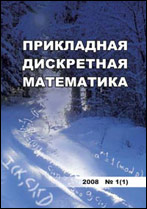|
This article is cited in 2 scientific papers (total in 2 papers)
Theoretical Backgrounds of Applied Discrete Mathematics
Bernoulli's discrete periodic functions
M. S. Bespalov
Vladimir State University named after Alexander and Nikolay Stoletovs, Vladimir, Russia
Abstract:
This paper is a survey of known and some new properties of the discrete periodic Bernoulli functions $b_n(j)$
of order $n$ introduced by V. N. Malozemov
and viewed as elements $x=x(0)x(1)\ldots x(N-1)\in\mathbb C_0^N\subset \mathbb C^N$ with the normalization condition $\sum\limits_{k=0}^{N-1} x(k)=0$.
It is proved that the operator $\Delta:\mathbb C_0^N\to\mathbb C_0^N$ where $\Delta [x]=y=y(0)y(1)\ldots y(N-1)$, $y(k)=x(k+1)-x(k)$, is a bijection and $\Delta[b_n]=b_{n-1}$. Moreover, according to Malozemov's result, the set of the discrete periodic Bernoulli functions is an infinite cyclic group relative to the cyclic convolution $x*y(s)=\sum\limits_{j=0}^{N-1}x(j)y(s-j)$ with a neutral element $b_0$, and $b_n * b_m=b_{n+m}$.
It is proved that either the set of $N-1$ cyclic shifts $x^{k\to}(j)=x(j-k)$ of any discrete periodic Bernoulli function or the set $\{b_m, b_{m+1},\ldots ,b_{m+N-2}\}$ yields a basis of the space $\mathbb C_0^N$. The generating function $\sum\limits_{n=0}^{\infty} b_n t^n$ of a sequence of discrete periodic Bernoulli functions is calculated.
Formulas $\sum\limits_{k=1}^{N-1}\sin^{2m}({\pi k}/{N})$, $m\in\mathbb Z$, for calculating the sums of even degrees of sinuses at equidistant nodes of a circle are found by means of these functions and the discrete Fourier transform.
It has been established that a cyclic shift by 1 and the multiplication by $ -N$ transform these functions of positive order into special polynomials $P_n(k)$, which were introduced by Bespalov and Korobov and have become popular as the Korobov polynomials of the first kind in the form $K_n(x)=n!P_n(x)$. We have calculated the Korobov numbers $K_n=-n!\cdot N\cdot b_n(1)$ up to $K_{13}$ and the Korobov polynomials up to $K_7(x)$ for any array size (parameter) $N$.
Keywords:
discrete Fourier transform, cyclic convolution,finite difference, generating function, Korobov numbers and Korobov polynomials.
Citation:
M. S. Bespalov, “Bernoulli's discrete periodic functions”, Prikl. Diskr. Mat., 2019, no. 43, 16–36
Linking options:
https://www.mathnet.ru/eng/pdm650 https://www.mathnet.ru/eng/pdm/y2019/i1/p16
|

|




 Contact us:
Contact us: Terms of Use
Terms of Use
 Registration to the website
Registration to the website Logotypes
Logotypes








 Citation in format
Citation in format 
